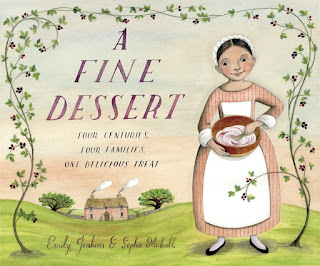The days immediately after giving birth to each of my children passed in a surreal fog. I remember waking in the night to nurse and feeling flooded with wonder again and again – that this miraculous creature had come into being. This child I had dreamed of, hoped for, imagined, dared-not-imagine, was actually real.
I am feeling much the same way right now.
As I wrote in a Facebook post last week, “2015 was something of a fraught year for book making. I have been learning from all the discussions and am trying to use what I've learned to feel encouraged and inspired rather than paralyzed. Emphasis on trying.
But the year is young! And there are books to be made!”
There was such an outpouring of love and encouragement in response to this. I was – and remain – so grateful.
I decided to banish all thought of the Caldecott from my head. But it kept creeping back in. I wrestled with it all weekend.
Who are you to hope? I asked myself, in Maggie Smith’s most withering voice… and then I imagined getting the call, imagined every detail. When I imagine something, it usually ends up in a drawing, not as a reality. I was pretty sure that the very act of imagining it was enough to prevent it coming true.
In my sleeplessness I should have picked up an
old friend of a book but instead I wandered the internet, fueling the fire.
And then I read three things which helped enormously.
The first was Kimberly Brusker Bradley’s
blogpost.
“I want to win the Newbery so bad it makes my teeth hurt”, she wrote.
“And yet, it doesn't really matter at all.
Both of these things are absolutely true.”
And this made me realize there’s nothing wrong with hoping.
The second was Susan Kusel’s
post, which reminded me that whatever happened on Monday morning was out of my control, and unpredictable, and whether I hoped or fretted or slept like a cat, it wouldn’t make a jot of difference.
And her words together with
this letter to which she linked, (which I now learn was written by Sarah Bean Thompson, a member of the committee. Thank you Sarah!), made me feel
calm.
It gave me enormous confidence in the process and the committee. I don't envy their task, but I have such respect for their commitment and patience and attentiveness and open mindedness and willingness to work together. I realized that they would choose the right book, whichever book that happened to be.
And so I went to sleep.
I’m lying. I didn't really sleep at all.
I’d heard the call usually comes before 6:30am. So by 6:31am, I’d resigned myself that it was not to be. I hopped in the shower. Made Eggy’s school lunch. Told Ed we could relax. It wasn’t going to happen. We had a lovely sad-happy moment of realizing that Caldecott or no, we were very lucky people indeed.
And then the phone rang.
The rest is a blur. I think my legs gave way. I may have sobbed. It’s still utterly surreal that your life can turn around in a span of minutes. It will take a lot longer to adjust to the idea that my name falls at the end of this list of luminaries: Virginia Lee Burton. Maurice Sendak. Ezra Jack Keats. Barbara Cooney. The Provensons. O. Zelinsky. Wiesner. Selznick. Pinkney. Stead. Raschka. Klassen. Floca. Santat.
I’m so grateful to the committee and can’t wait to thank you all in person.
The sound of a room of laughing, cheering librarians coming down the wire will stay with me forever.
I am so fortunate to have worked with Little, Brown and thank everyone there for their part in making this book.
Susan Rich, our editor, is on every page of Finding Winnie, and this award belongs every bit as much to her.
Without Lindsay Mattick’s extraordinary family story, this book wouldn’t exist. I thank her for sharing it with me.
My studio mates are my best friends and five years on, I can’t believe how lucky I am that we get to do this together every day.
Ed, who held me up in the kitchen when my legs went wobbly, and who holds me up each and every day, my children and fake children, all of whom I adore, and dear family and friends who make my life and the world a better place,
My father, to whom this book is dedicated,
John Schu who has loved this book enough for all of us,
Laura Amy Schlitz who I've decided is my fairy godmother, warm and wise,
Nancy Gallt and Marietta Zacker, thank you.
And to all the librarians and teachers and ambassadors of children’s literature for reading and reviewing, discussing and sharing books with unflagging dedication, respectful debate and contagious enthusiasm. Your extraordinary efforts to get those books into the hands of children, your love for books and those who read them is indeed encouraging and inspiring.
And thank you to EVERYONE for your kind words.
I am overflowing with gratitude.
































































